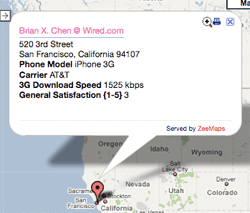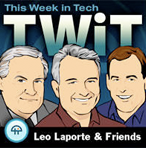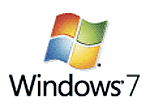 Never assume RIM is toast:
Never assume RIM is toast:
BlackBerry Curve outells the iPhone.
Two trends conspiring against Microsoft.
Navigon exits North American market.
“Houdini’s” a great phone name.
MySpace formulates its turnaround strategy.
 Never assume RIM is toast:
Never assume RIM is toast:
BlackBerry Curve outells the iPhone.
Two trends conspiring against Microsoft.
Navigon exits North American market.
“Houdini’s” a great phone name.
MySpace formulates its turnaround strategy.
 Wired.com, which published an eye-opening survey of iPhone 3G users’ experiences with data last August, is doing it all over again–but this time, it’s expanding its scope to test the 3G networks of all the major U.S. wireless carriers: AT&T, Sprint, T-Mobile, and Verizon Wireless. It’s a public service, and whatever the results are, they’ll be interesting. This article explains how to participate, which you do by running interactive tests on your smartphone.
Wired.com, which published an eye-opening survey of iPhone 3G users’ experiences with data last August, is doing it all over again–but this time, it’s expanding its scope to test the 3G networks of all the major U.S. wireless carriers: AT&T, Sprint, T-Mobile, and Verizon Wireless. It’s a public service, and whatever the results are, they’ll be interesting. This article explains how to participate, which you do by running interactive tests on your smartphone.
I’m going to do just that on my iPhone–hope you do, too.
 [UPDATE: Amazon’s announcing something on Monday–it’s sent out invites to journalists for a press event in New York.]
[UPDATE: Amazon’s announcing something on Monday–it’s sent out invites to journalists for a press event in New York.]
The New York Times is reporting that Amazon.com is about to introduce a larger-screen version of its Kindle e-reader, tailored for magazines, newspapers, and, possibly, textbooks. If so, it would be an early entrant in what’s shaping up to be a bustling race of new e-readers that set out to save the magazine and newspaper industries. But my guess is that any Kindle variant that’s imminent isn’t going to be an industry-rescuing breakthrough.
Dozens of magazines and papers are already available on the current Kindle, and while that’s a good thing, the presentation and navigation are disappointing. You don’t get the original color layouts of the printed page or the interactivity of the Web. It’s hard to hop around between stories in anything but sequential fashion, and the Kindle’s sixteen shades of greenish gray can’t compete with the full color of the printed page.
If I had to make a call on which was the superior way to read magazine content–on the Web or in print–I’d need to think it over. But I do know that Kindle magazines, in their current form, lag behind both of those options.
A big-screen kindle that displayed magazine pages in their original layout at something close to full size would be an intriguing device, but without color, it wouldn’t be an exciting one. And there’s no way that even a large Kindle is going to show magazine pages in their traditional layout (although it’s an entertaining idea–maybe the screen could fold in half so you could fit the thing into a briefcase)?
Amazon’s not about to reveal that the E-Ink technology used in the Kindle can now do color, and my guess is that the company is unwilling to release a color-screen Kindle that can’t run for days on a battery charge. So any almost-here big Kindle likely uses the E-Ink screen, and does at least some reformatting of material. If it’s essentially the same Kindle 2 that Amazon sells today except that it crams more words onto the screen, it’ll be a relatively minor edition to the Kindle lineup. (I have a pretty long list of criticisms of the Kindle 2, but the amount of wordage per screen isn’t one of them.)
Maybe Amazon has come up with a way to make moving through issues and stories less of a plodding, front-to-back affair. If so, that would be a more significant step forward than any hardware it’s likely to announce–and I hope it would brings it to us owners of small-screen Kindles, too.
 I’m happy to report that I’m going to be on Leo Laporte’s This Week in Tech on May 3rd (hey, that’s tomorrow–Sunday!). It’ll broadcast live at 3pm PT before it becomes a podcast. I know that one of the other guests will be the Houston Chronicle’s intrepid tech editor, Dwight Silverman.
I’m happy to report that I’m going to be on Leo Laporte’s This Week in Tech on May 3rd (hey, that’s tomorrow–Sunday!). It’ll broadcast live at 3pm PT before it becomes a podcast. I know that one of the other guests will be the Houston Chronicle’s intrepid tech editor, Dwight Silverman.
I always have a good time on the show, and always come away impressed by how many smart folks are Leo fans. (It’s an honor when they discover Technologizer, too.) Hope you’ll tune in!
 I was one of the few tech journalists who didn’t mock Palm’s Foleo device when founder Jeff Hawkins unveiled it at D two years ago–see my fuzzy photo to the left–and who chose not to tapdance on its grave when Palm decided not to release it after all. (Um, actually I may have been the only pundit who treated the Foleo, which was a sort of browser-in-a-subnotebook-that-talked-to-your-wireless-phone, with a shred of respect.)
I was one of the few tech journalists who didn’t mock Palm’s Foleo device when founder Jeff Hawkins unveiled it at D two years ago–see my fuzzy photo to the left–and who chose not to tapdance on its grave when Palm decided not to release it after all. (Um, actually I may have been the only pundit who treated the Foleo, which was a sort of browser-in-a-subnotebook-that-talked-to-your-wireless-phone, with a shred of respect.)
So I like today’s rumor that the Foleo was not dead, but just resting: Analyst Trip Chowdry says that Palm has some iPod veterans working on a new version. If he’s correct, I don’t expect the blogosphere to formally retract all the nasty things it said in 2007. But it’s undeniable that the notion of a cheap, small computer that’s designed mostly to run Web apps rather than client software is no longer deserving of contempt: We now know the concept as the netbook, and it seems to be doing just fine in the market.
In other words, Jeff Hawkins wasn’t dumb, he was just ahead of his time–something which anybody who’s followed Hawkins’ career should have been able to figure out in the first place.
There’s actually every reason to think that Palm is indeed working on a new Foleo–because when CEO Ed Colligan killed the first one, he said it would be back, and it would be based on the platform which we now know is called WebOS:
Jeff Hawkins and I still believe that the market category defined by Foleo has enormous potential. When we do Foleo II it will be based on our new platform, and we think it will deliver on the promise of this new category. We’re not going to speculate now on timing for a next Foleo, we just know we need to get our core platform and smartphones done first.
Which doesn’t mean that I’m assuming Chowdry is right. He’s the same guy who said he believed that Costco would be selling $149 iPhones last January, and who saw Google losing its technical edge to search startup Powerset a couple of years ago. But in this case, I’m guessing that Chowdry, like Hawkins, has the right instincts–and the only question is whether he got the timing right,
![]() Intuit, the company whose Quicken has been synonymous with personal-finance management for years, has brought the app to the iPhone. It’s not the first version of Quicken for handheld devices–I used an earlier one on my PalmPilot years ago–but it’s the first modern one. And as its name, Quicken Online Mobile, suggests, it connects directly to the Net to grab your financial details rather than making you sync with the desktop app.
Intuit, the company whose Quicken has been synonymous with personal-finance management for years, has brought the app to the iPhone. It’s not the first version of Quicken for handheld devices–I used an earlier one on my PalmPilot years ago–but it’s the first modern one. And as its name, Quicken Online Mobile, suggests, it connects directly to the Net to grab your financial details rather than making you sync with the desktop app.
Actually, it doesn’t work with the traditional application version of Quicken at all–it’s a companion to Quicken Online, the Web-based version which relaunched in a free version last fall. If you’re like me, you tend to associate use of Quicken with personal-finance nerds who have their acts together, track everything carefully, and are on the road to a happy and prosperous retirement. Quicken Online isn’t aimed at those people: It’s got relatively few features, is heavy on automation (like Mint, it downloads transactions from your banks and credit-card companies automatically), and most of what it does is focused on making sure that you’ve got enough money to get to your next paycheck. Quicken Online Mobile brings that approach to the iPhone and iPod Touch, and does a nice job at it. You can see what you’ve spent and what you’ve made, and the home screen tallies everything up and tells you whether you’re in any risk of running out of dough.
 A happy May to you!
A happy May to you!
Swine flu tracking for iPhone.
The 240GB iPod upgrade option.
Twittering from the White House.
Apple’s next iPhone: Flip replacement?
Twitter administrator account gets hacked.
The military’s ultrasecure Windows XP.
Dell offers 120 laptop designs.
One major bright spot during Palm’s recent rocky history has been the success of its Centro–a Palm OS device that’s cheap, small, simple, and a best-seller. Even once the far fancier Pre is out, you’d think that Palm wouldn’t want to abandon the low end of the market. And it looks like you’d be right: Engadget has a photo and some other details on a WebOS phone allegedly called the Eros Eos which is allegedly coming to AT&T. If it’s real, it looks like the Centro’s successor. And even if it’s someone’s fantasy…well, the basic idea is so logical that I’d be stunned if Palm doesn’t come up with something similar. And with the Pre debuting exclusively on Sprint, it also makes perfect sense for the company to have something else it can sell via other carriers to keep its partnerships with them from fading away.
 When Microsoft set a release schedule for the Windows 7 Release Candidate–which will apparently be the last major version before it finalizes the OS–it said that members of its TechNet service for IT types would get it on April 30th, and everyone else would have to wait until May 5th. If that was to ensure trouble-free downloads for everyone involved, it didn’t work: As Ed Bott reports, a database glitch prevented a lot of TechNet members from getting the download.
When Microsoft set a release schedule for the Windows 7 Release Candidate–which will apparently be the last major version before it finalizes the OS–it said that members of its TechNet service for IT types would get it on April 30th, and everyone else would have to wait until May 5th. If that was to ensure trouble-free downloads for everyone involved, it didn’t work: As Ed Bott reports, a database glitch prevented a lot of TechNet members from getting the download.
I had trouble myself, at first–but now, the download seems to be proceeding properly. I plan to install the RC on both a general-purpose notebook and a netbook, and look forward to sharing impressions. And if you snag the RC–either right now or at any time between now and general release–I’d love to know what you think.
 Hulu was already by far the most ambitious and interesting purveyor of free video from traditional sources on the Web. Today, it’s taking a great big step towards solidifying its lead: The Walt Disney Company is joining NBC and Fox as a partner in the venture, getting an ownership stake and providing content it owns.
Hulu was already by far the most ambitious and interesting purveyor of free video from traditional sources on the Web. Today, it’s taking a great big step towards solidifying its lead: The Walt Disney Company is joining NBC and Fox as a partner in the venture, getting an ownership stake and providing content it owns.
The deal will bring shows such as Lost, Grey’s Anatomy, Desperate Housewives, Scrubs, and Jimmy Kimmel Live to Hulu, along with old episodes of Dancing With the Stars and Who Wants to Be a Millionaire, plus stuff from other Disney outfits like the ABC Family Channel and SOAPNEt. Movies from the Disney library will also be available.
Me, I’m most interested in the one type of content that first leaps to mind when you think of the word “Disney.” That would be classic animation in short-subject and feature-length form. Oddly enough, that’s just about the only thing that isn’t mentioned specifically in the announcement. Mickey, Minnie, Dumbo, and Bambi, where are you?
